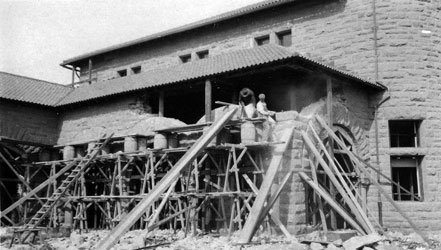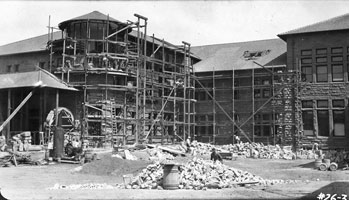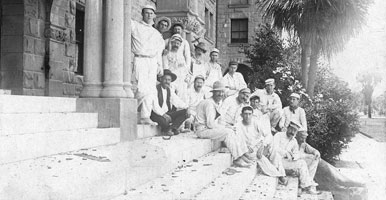|
|
||||||||||
 |
|
|
|
|||||||
|
|
||||||||||
|
|
|
|
|
|
|
|
|
|||
|
|
|
|
|
|
|
|
|
|
|
|
Themes | Campus Reconstruction
Reconstruction of the Outer Quad gets underway. |
The day after the earthquake, William James, visiting Professor of Philosophy from Harvard, wrote to President David Starr Jordan. James captured the faculty’s fear of a return to the “stone age,” a term applied to the long period of construction under Jane Stanford, during which resources for the academic program took a back seat to the building of the physical plant. He urged that only those buildings needed for instruction be repaired, and that others be left as monuments to the earthquake and appeals to future donors. He argued it was time to focus the endowment on building the academic program, with appropriate salaries for professors.
A committee composed of Stanford professors, Charles D. Marx, civil engineering, Charles B. Wing, structural engineering, William F. Durand, mechanical engineering, and Arthur B. Clark, graphic art, along with campus architect, Charles B. Hodges, was appointed by the Board of Trustees to survey the damage on campus. The committee, called the Stanford Commission of Engineers, focused on those buildings critical to the university’s academic program, and reported to the Board in May that the buildings “necessary for carrying on the university work can easily be made ready for occupancy and safe use in time for the opening of the University on August 23rd.” Three outside consultants--Henry A. Schulz, architect, J.D. Galloway, civil engineer, and J.B. Leonard, civil engineer-- were hired to provide a more detailed building condition report, with recommended repairs and estimated costs.
Decisions made in subsequent months reflected the advice offered by James. The monumental buildings commissioned by Jane Stanford that had kept the university’s funds encumbered for so many years–Men’s Gymnasium, Library, Museum additions, Memorial Arch--were left in ruins. Plans for reconstruction of the Church were deferred. Attention was given to the Main Quadrangle buildings, the dormitories, and the Chemistry building. Even then, it would be two and a half years before repairs to the central academic structures were complete.
Repairs to the Physics building. |
Armed with the outside consultants’ report, which estimated the cost of reconstruction at $1,781,384, the Stanford Commission of Engineers began the process of repairing selected buildings ten weeks after the earthquake. The consultants’ report was quite blunt in its assessment of Stanford structures. The “mechanical workmanship” evident in the Inner Quad buildings, they wrote, was superior to that found in more recent construction, where structural integrity had been compromised by poor design. Consequently, repairs of the Outer Quad, far more involved than those for the Inner Quad, would require more time and a good deal more money. Only plaster and stonework repair were needed in the Inner Quad. Cost estimates for some of those buildings were no more than $100.
Under direction from the Board of Trustees, the commission focused their efforts on the two dormitories, Roble and Encina, and Outer Quad buildings, including the Assembly Hall, Thomas Welton Stanford Library, and Physics corner. Contracts were signed and construction began in early July, barely two months before students were to return. A labor strike in late July threatened further delays, but sufficient repairs were completed to allow the university to reopen for the fall semester.
Workers pose outside Encina Hall during reconstruction. |
From June 1906 until December 1908, the commission submitted periodic reports detailing the rebuilding process. Unexpected problems, the need for more involved repairs, and the lack of specialized workmen and supplies were recurring themes in the reports. When repairs requested by the Board of Trustees had been completed, the commission issued its final report, including the total funds expended. The difference between the consultant’s estimate and the actual expense can be attributed to postponing reconstruction of the church and dismantling the new library and gymnasium. Those three buildings alone accounted for $955,000 of earthquake-related costs on the campus. The library and gym were never rebuilt as originally sited and designed, but the repair and strengthening of Memorial Church began in 1908 and was completed in 1917.
The Stanford campus would never look the same as it did on April 17, 1906, but the university met the challenge head on and eventually recovered from the devastating quake. Enrollment for the academic year, 1906-07 was down from the previous year by just over a hundred students. No study was done to determine which students did not return, but the President’s Report ascribed the drop to students from outside California not coming back. Student numbers soon returned to pre-earthquake levels, and the university moved forward from that April morning, expanding its academic program, hiring new professors, and educating students as the Founders had wished. Perhaps William Fraser Herron captured it best when he wrote in the 1908 Stanford Quad, “Suddenly it came, suddenly it left; brief was its visitation—but its traces were deep and enduring.”
View of campus after Memorial Arch was dismantled.


